|
|
|
Sort Order |
|
|
|
Items / Page
|
|
|
|
|
|
|
| Srl | Item |
| 1 |
ID:
059113
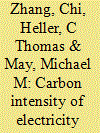

|
|
|
| 2 |
ID:
181734
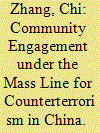

|
|
|
|
|
| Summary/Abstract |
The mass line principle offers an alternative approach to mobilize citizens to participate in governance. The key tenets of the mass line principle resemble that of the regime of community engagement, aiming at encouraging democratic participation, improving the trust between the rule and the ruled, and improving the ability of the government to gather intelligence. In the context of China’s counterterrorism strategy, the mass line involves the encouraging citizens’ participation in the People’s War on Terror, incentivizing individuals to provide tip-offs, and engaging patriotic believers, opinion leaders, grass-roots propagandists, and cultural workers to persuade and educate the masses to adopt “correct” views. In addition, the government seeks to publicize the voice of Uyghurs from within the community. However, such efforts only served as evidence for intolerance for diversity and an invitation for further suspicion and criticism. This article demonstrates the trust dilemma the state faces—in order to improve democratic participation, the efforts to engage a community and gather intelligence often result in eroding the trust. This article also highlights the importance of differentiating harmony and political conformity. Diversity per se is not the source of conflict, but it is often targeted by the state as it is desperately seeking to demonstrate efficacy in the face of terrorism.
|
|
|
|
|
|
|
|
|
|
|
|
|
|
|
|
| 3 |
ID:
178931


|
|
|
|
|
| Summary/Abstract |
This paper contributes to the debate on terrorism designation and proscription by providing information and analysis on the “double-track” system of terrorism designation and proscription in China. It calls for greater attention to China’s terrorism proscription system as China has increased its engagement in international affairs and became more willing and capable of international cooperation in counterterrorism. The case of China provides important insights from a non-Western perspective into how states function in dealing with the challenge terrorism poses. In particular, it examines China’s efforts in balancing effective counterterrorism and the accountability of the government. Adopting an interpretivist approach based on primarily Chinese-language documents, it traces the development of China’s proscription regime since 2003 to illustrate its evolution from ad-hoc list-making to a more complicated system. Because of the difficulties in collecting information and presenting it as admissible evidence in court, like many other countries, China relies on the executive for terrorism designation and proscription. While the workings of China’s proscription system demonstrates authoritarian characteristics, the development of its proscription regime reveals how it sought to respond to the concerns about the legitimacy of its counterterrorism practice, for example, on issues of due process and presumption of innocence.
|
|
|
|
|
|
|
|
|
|
|
|
|
|
|
|
| 4 |
ID:
192128
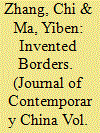

|
|
|
|
|
| Summary/Abstract |
Patriotic campaigns and mass mobilization draw on existing xenophobic attitudes of the public, reinforcing the ‘us vs. them’ dualism between China and ‘the West’. However, patriotic campaigns are not always top-down, state-led, nor are they always primarily driven by political ideology. Patriotic content appeals to a growing nationalist audience who consumes a mixed feeling of perceived victimization at the hand of foreign aggression and the pride arising from being a Chinese citizen. This paper argues that the profitability of patriotic content circulating on social media exacerbated the tension between market-driven grassroots patriotism and state-led patriotic campaigns. The tension grows out of, and is manifested in, the online popular debate around economically driven, grassroots ‘patriotic’ content that can challenge the state state-led patriotic rhetoric. While the state sometimes strategically co-opts some patriotic contents into its own patriotic narratives, it also delegitimises other undesired ones through labels such as ‘high-level black’ (gaoji hei) or ‘low-level red’ (diji hong). These labels were initially used to differentiate meticulously crafted political satire and parody from incompetent, illogical and vulgar propaganda pieces that unintendedly blemish the state’s patriotic campaigns, but later evolved into an exercise of power to distance the CCP from undesired patriotic content.
|
|
|
|
|
|
|
|
|
|
|
|
|
|
|
|
| 5 |
ID:
179953
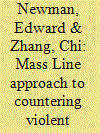

|
|
|
|
|
| Summary/Abstract |
As a strategy to temper centralized governance with a degree of public participation in China, the “Mass Line” approach has been used throughout the history of the Chinese Communist Party (CCP) to mobilize citizens in support of national projects and use this engagement as a channel for feedback. The Mass Line has been employed in attempts to address “radicalization” and challenges to centralized state control, indicating that the CCP’s approach to counter-terrorism goes beyond the top-down, oppressive tactics that China is often associated with. This paper explores China’s programmes of mass mobilization as a part of its counter-radicalization strategy in order to deepen understanding of how the country is responding to a key security challenge. It demonstrates that this approach reflects significant historical continuities, and thus national characteristics, in terms of political culture and state control.
|
|
|
|
|
|
|
|
|
|
|
|
|
|
|
|
| 6 |
ID:
177157
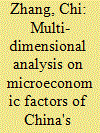

|
|
|
|
|
| Summary/Abstract |
Reducing energy intensity is the key point to solve the contradiction among economic development, energy constraints and environmental pressure in China. Considering microeconomic factors, this paper extends decomposition and attribution models, and analyses the drivers of China's industrial aggregate energy intensity (AEI) at the regional/sectoral level. The results show that AEI decreased by 49% during 2000–2017. At the regional level, most provinces presented negative contribution on regional energy intensity effect. The AEI decline was attributed to the drop of greatest negative effect of R&D efficiency in Liaoning. The increase in investment intensity and R&D intensity lead to an increase in AEI, largely owning to Shandong and Liaoning, respectively. At the sectoral level, the AEI decline can be mainly explained by the inhibition effect of energy intensity and R&D efficiency. However, this negative contribution was greatly offset by the R&D intensity effect. The investment intensity showed a positive impact in AEI increase, and smelting and pressing of ferrous metals sector was the main contributor. Regional and sectoral investment structure effect shifted from increasing to decreasing AEI over the study period. Based on the results, targeted policy recommendations are proposed to further decrease the China's industrial AEI in the 14th FYP period.
|
|
|
|
|
|
|
|
|
|
|
|
|
|
|
|
|
|
|
|
|